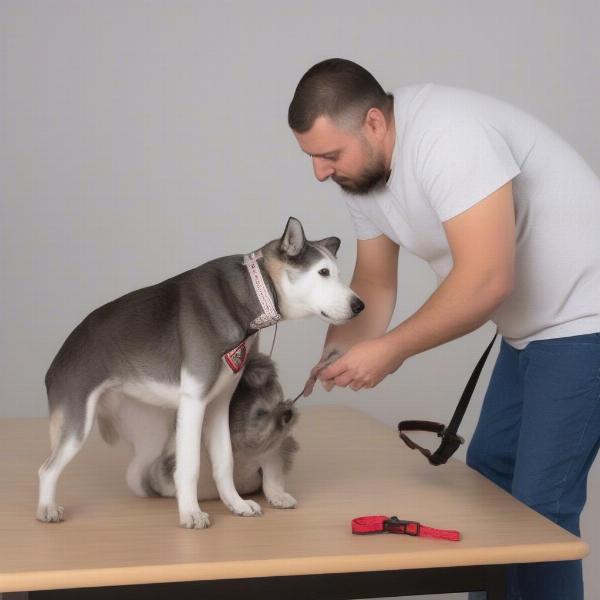Head collars, also known as head halters, are a training tool designed to gently manage a dog’s pulling behavior on leash. They work by redirecting the dog’s head and therefore their body, providing more control and reducing strain on both the dog and the handler. They are a popular choice for dog owners struggling with leash reactivity or strong pullers, but it’s crucial to understand how to use them correctly to ensure their effectiveness and your dog’s comfort.
Understanding How Head Collars Work
Unlike traditional collars that put pressure on the dog’s sensitive trachea, head collars work on the principle of leverage. The collar loops around the dog’s muzzle and behind the ears, similar to a halter for a horse. When the dog pulls, the collar gently turns their head, interrupting their forward momentum and redirecting their attention back to the handler. This allows for gentle guidance and prevents choking or gagging. Head collars are particularly helpful for dogs that are strong or reactive on leash, making walks more enjoyable for everyone.
Choosing the Right Head Collar for Your Dog
Choosing the right head collar is crucial for your dog’s comfort and the effectiveness of the tool. There are several different brands and styles available, each with its own unique features. Some popular options include the Gentle Leader, Halti, and Snoot Loop. When selecting a head collar, consider your dog’s breed, size, and muzzle shape. A properly fitted head collar should sit snugly but not too tight, allowing the dog to pant and yawn comfortably.
Introducing Your Dog to the Head Collar
Introducing a head collar to your dog should be a gradual and positive process. Start by letting your dog sniff and investigate the head collar. Reward them with treats and praise for showing interest. Gradually introduce the collar by briefly placing it on your dog’s muzzle and rewarding them. Slowly increase the duration of wear, associating the head collar with positive experiences. Never force the head collar onto your dog, as this can create negative associations and make them resistant to wearing it.
Using a Head Collar Effectively
Using a head collar effectively involves more than simply attaching it to your dog. It requires proper leash handling techniques and consistent training. Keep the leash loose and avoid jerking or pulling on it. Use gentle, directional cues to guide your dog. Reward your dog for walking calmly by your side. Remember, the head collar is a tool to aid in training, not a quick fix. Consistency and patience are key to achieving desired results.
 Dog owner properly fitting a head collar
Dog owner properly fitting a head collar
Are Head Collars Right for Every Dog?
While head collars can be beneficial for many dogs, they are not suitable for every situation. Dogs with certain medical conditions, such as brachycephalic breeds with respiratory issues, may not tolerate head collars well. Consult with your veterinarian or a certified dog trainer to determine if a head collar is the right choice for your dog. They can also guide you on proper fitting and usage.
Conclusion
Head collars for dogs can be a valuable tool for managing pulling and leash reactivity, making walks more enjoyable for both you and your dog. head collar for dogs offer a humane and effective way to gain control while preventing choking and discomfort. Remember to choose the right head collar, introduce it gradually, and use it with proper techniques. By understanding how to use a head collar effectively, you can transform your walks from a struggle into a pleasant experience.
FAQ
- Are head collars cruel? No, head collars are not cruel when used correctly. They provide gentle guidance and prevent choking, unlike traditional collars that can put pressure on the trachea.
- Can my dog eat and drink with a head collar on? Yes, most dogs can eat and drink comfortably while wearing a properly fitted head collar.
- How long can my dog wear a head collar? Start with short periods and gradually increase the duration as your dog becomes accustomed to it. Avoid leaving the head collar on for extended periods unsupervised.
- What if my dog paws at the head collar? This is a common reaction as dogs adjust to the new sensation. Distract your dog with treats or praise and continue positive reinforcement. donut collar for dogs might be an alternative to consider if pawing persists.
- Can head collars be used on puppies? Yes, head collars can be used on puppies, but it’s important to choose a size appropriate for their age and breed. grateful dead dog collar offer stylish options for various dog sizes.
- My dog is a large breed, will a head collar work? Yes, head collars are available for all breeds and sizes, including large breeds. Consider a mastiff dog collars if you have a particularly strong dog.
- Are there any alternatives to head collars? Yes, alternatives include harnesses, front-clip harnesses, and training techniques focused on loose-leash walking. It might also be interesting to explore whether can dogs get their ears pierced for identification purposes.
ILM Dog is a leading online resource for dog owners worldwide, offering expert advice on dog care, training, and wellbeing. We provide evidence-based information on various topics, from breed selection to senior dog care. Our goal is to empower dog owners with the knowledge and resources they need to provide the best possible care for their furry companions. Contact us at [email protected] or +44 20-3965-8624 for personalized guidance. ILM Dog is dedicated to helping you build a strong and loving bond with your dog.